Gold the Hedge Against Chaos
Commodities / Gold and Silver 2010 Aug 05, 2010 - 03:21 AM GMTBy: Darryl_R_Schoon

 …what if history is not cyclical and slow-moving but arhythmic, at times almost stationary, but also capable of accelerating suddenly, like a sports car? What if collapse does not arrive over a number of centuries but comes suddenly, like a thief in the night… dramas lie ahead as the nasty fiscal arithmetic of imperial decline drives yet another great power over the edge of chaos. Niall Ferguson, July 28, 2010
…what if history is not cyclical and slow-moving but arhythmic, at times almost stationary, but also capable of accelerating suddenly, like a sports car? What if collapse does not arrive over a number of centuries but comes suddenly, like a thief in the night… dramas lie ahead as the nasty fiscal arithmetic of imperial decline drives yet another great power over the edge of chaos. Niall Ferguson, July 28, 2010
The nasty fiscal arithmetic of imperial decline that Harvard professor Niall Ferguson refers to is America’s unsustainable debt. Growing levels of debt according to Ferguson are now about to drive the US, like other great powers before it, over the edge of chaos; an event Ferguson believes will come sooner rather than later.
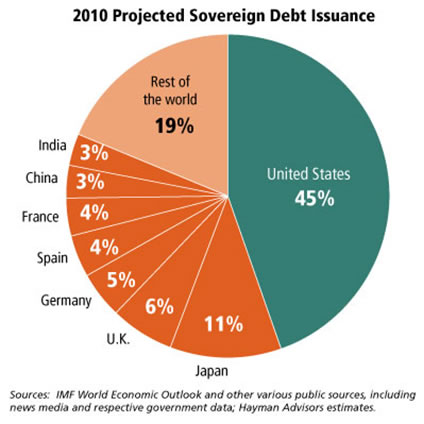
…most imperial falls are associated with fiscal crises…empires behave like all complex adaptive systems. They function in apparent equilibrium for some unknowable period. And then, quite abruptly, they collapse.
In 2010 the U.S. government is expected to issue almost as much new debt as all other governments, around the world, combined
The resemblance between the above chart and the following is obvious—except, of course, to those in denial.
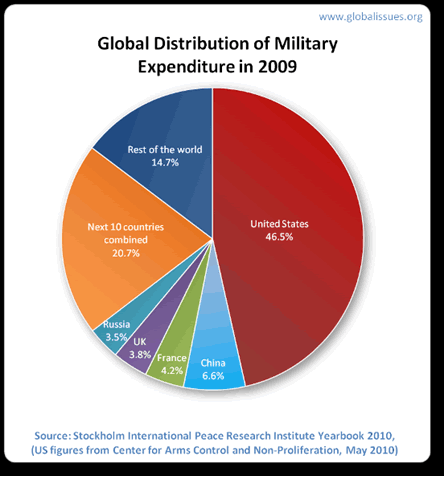
The US borrows 45 % of all moneys borrowed by all governments and spends virtually that same percentage of global military spending. Beginning in 1980, President Reagan started the US on the road to financial collapse, borrowing heavily in order to fund the US military buildup, an act of fiscal irresponsibility that would later prove fatal. In his two terms, Reagan increased the US national debt by 258 %, the cost of which would be the loss of America’s economic power-base.
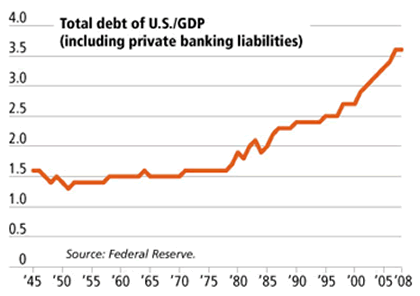
After WWII, both the USSR and the US spent vast amounts of their respective GDPs on military expenditures. Bankrupted, the USSR collapsed in 1992. Three decades later, the US now faces the same fate.
America’s pending bankruptcy reflects America’s shift from the world’s creditor to its largest debtor. Prior to Reagan’s military buildup, the US did not need to borrow to support the global deployment of its military; instead, in order to do so the US spent its entire hoard of gold—21,775 tons.
The only gold the US now possesses is there because in 1971 the US refused to convert its remaining gold for dollars as required under Bretton-Woods; and by the time Reagan was elected, the US could pay for its global military force only by indebting itself to others
When Reagan took office, total US debt was $980 billion. Today, the budget deficit for this fiscal year alone is projected to be $1.4 trillion. After the Reagan presidency, the US accelerated its spending until sovereign default or currency debasement are its only options.
SOVEREIGN DEBT SOVEREIGN DEFAULT SOVEREIGN DENIAL
The Emperor has no clothes, i.e. the empire has no money
The publication of Rogoff and Reinhart’s seminal work on sovereign debt in 2008 predated the sovereign debt crisis by two years; and if Rogoff and Reinhart were not surprised, they would be surprised that it would be industrialized nations that would find themselves under the scrutiny of global debt collectors.
In 2010, sovereign default concerns unexpectedly shifted from developing nations, i.e. Rogoff and Reinhart’s sovereign rite of passage, to industrialized nations—Greece, Spain, Italy, the UK, the US, and Japan etc.
The shift in sovereign debt concerns was accompanied by another extraordinary shift. Between 2000 and 2010, China became America’s creditor as well as its sweatshop; and China knows that the US owes so much money that only by borrowing more can it pay what it owes, a condition economist Hyman Minsky called ponzi-financing, the last stage prior to debtor default.
In truth, the US is not the default virgin described in Rogoff and Reinhart’s study. The US default on its gold obligations was perhaps the most important monetary default in history, plunging the entire world into a regimen of fiat money against its will
Sovereign default, however, is not the only strategy available to the US regarding its unpayable debt. The US could alternatively pay down its massive obligations by debasing its currency, a strategy wherein the US would pay its creditors with increasingly worthless US dollars—to the US, a far more convenient solution.
This is why China is worried—and the rest of the world (including Americans) should be worried too.
BORROW BORROW BORROW SPEND SPEND SPEND
No one will be surprised when the US again tries to borrow its way back to economic growth. This has been the default strategy of the US ever since Ronald Reagan’s Treasury Secretary, Donald Regan said, “Deficits don’t matter”, a financial heresy that would eventually undermine the American economy.
Capitalism is an uneasy balance between credit and debt. However, in the 1980s, far more credit was created and far more debt resulted. Combined with the removal of gold as a constraint on monetary growth, it would be only a matter of time until capitalism’s accrued debt would overwhelm the capacity of credit to contain and service it. That time has now arrived.
Bankers have unleashed a beast they cannot contain. The beast is of their own making although they are careful to deny their patrimony. The bankers’ deflationary black hole of defaulting debt is now destroying capital faster than bankers can create it.
This is why Fed Chairman Ben Bernanke is contemplating flooding the US economy with even more printed dollars, the so-called helicopter drop of money (Milton Friedman’s term), the proscribed solution of Milton Friedman to the Great Depression.
Because Friedman observed that the money supply had contracted during the Great Depression, Friedman erroneously believed sufficient monetary expansion would prevent another depression in the future. This is why Bernanke flooded the US with money and credit in 2009 hoping Friedman was right.
But Friedman was wrong. Bernanke’s palliative was temporary, producing only a short boost instead of a sustained recovery. Despite trillions of dollars spent and interest rates lowered to zero, the US money supply is still contracting—and the US economy is again slowing.
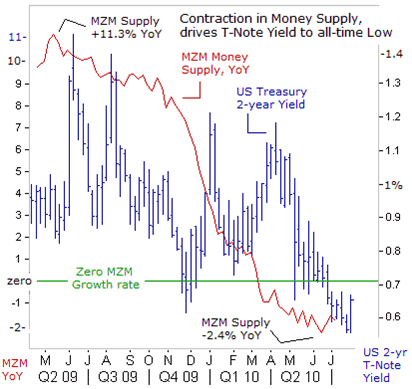
http://sirchartsalot.com/article.php?id=139
Despite Friedman’s failed theory, Bernanke still believes more injections of credit and debt can do what previous injections didn’t. This is akin to an alcoholic believing more alcohol will dispel the hangover that previous drinks did not. Friedman and Bernanke’s helicopters are coming. Get ready.

Can you hear the helicopters coming
Sounds of choppers fill the sky
Whirling birds of destruction
This is how currencies die
Printing money is easy
The problem is the debt
Money’s source is credit
You ain’t seen nuthin’ yet
Bernanke’s dream is our nightmare
His solution is our demise
Helicopters filled with money
Dropping from the skies
THE GOLDEN HEDGE AGAINST CHAOS
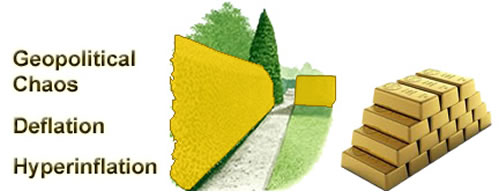
In The Critical Path (St Martin’s Press 1981) Buckminster Fuller predicted the world’s power structures would fall, plunging the world into an unprecedented crisis. Communism collapsed in 1992. Now, capitalism is about to do the same. Bucky’s predicted crisis comes next.
In The Great Wave (Oxford University Press 1996), Professor David Hackett Fisher observed we are at the end of a great wave—a phenomena that separates historical epochs, a phenomena which always end in the complete economic collapse of the existing order. Great Waves last 80 to120 years. The current wave is 114 years old.
At the 2010 Aspen Ideas Festival last month, Harvard Professor Niall Ferguson warned the collapse of the American empire could be imminent.
I think this is a problem that is going to go live really soon,” Ferguson said. “In
that sense, I mean within the next two years. Because the whole thing, fiscally and
other ways, is very near the edge of chaos..
When America’s empire does collapse and, like all empires, it will, chaos will reign. Today, the US is the world’s super power, its dollar is the world’s reserve currency. The collapse of the US will change all this and more.
This is why the price of gold has quintupled in only ten years. America’s failing grasp on power has been mirrored by gold’s rise during that same time. In 2000, America’s credit-driven prosperity began to falter with the collapse of the dot.com bubble. Ten years later, America has still not recovered. Indeed, as Niall Ferguson predicts, its demise is imminent.
Since the 1980s, the US has conspired with others to suppress the price of gold as it is an indicator of the failings of the fiat financial system upon which its power is based. This is akin to doctors icing the thermometer to convince others that the patient is not in danger; and while they have been successful in so doing, the patient is now about to expire.
When the US empire implodes, the global geopolitical matrix will collapse as will much of the world’s financial underpinnings. It will be a time of chaos; and gold—history’s hedge against chaos—will again perform its time-honored role.
RESPONSIBILITY AND RENEWAL
In an extraordinary mea culpa published July 31st in the New York Times, President Reagan’s Director of the Office of Management and Budget, David Stockman, a Republican, blamed his own party for four critical errors that contributed to America’s decline:
The errors are as follows:
The first of these started when the Nixon administration defaulted on American obligations under the 1944 Bretton Woods agreement to balance our accounts with the world. It is.. an outcome that Milton Friedman said could never happen when, in 1971, he persuaded President Nixon to unleash on the world paper dollars no longer redeemable in gold or other fixed monetary reserves. Just let the free market set currency exchange rates, he said, and trade deficits will self-correct. [But] relieved of the discipline of defending a fixed value for their currencies, politicians the world over were free to cheapen their money and disregard their neighbors…
The second unhappy change in the American economy has been the extraordinary growth of our public debt…This debt explosion has resulted not from big spending by the Democrats, but instead the Republican Party’s embrace, about three decades ago, of the insidious doctrine that deficits don’t matter if they result from tax cuts…
The third ominous change in the American economy has been the vast, unproductive expansion of our financial sector…the trillion-dollar conglomerates that inhabit this new financial world are not free enterprises. They are rather wards of the state, extracting billions from the economy with a lot of pointless speculation in stocks, bonds, commodities and derivatives. They could never have survived, much less thrived, if their deposits had not been government-guaranteed and if they hadn’t been able to obtain virtually free money from the Fed’s discount window to cover their bad bets.
The fourth destructive change has been the hollowing out of the larger American economy…It is not surprising, then, that during the last bubble (from 2002 to 2006) the top 1 percent of Americans — paid mainly from the Wall Street casino — received two-thirds of the gain in national income, while the bottom 90 percent — mainly dependent on Main Street’s shrinking economy — got only 12 percent. This growing wealth gap is not the market’s fault. It’s the decaying fruit of bad economic policy.
http://www.nytimes.com/2010/08/01/opinion/01stockman.html?pagewanted=1&_r=2&ref=opinion
Stockman’s mea culpa is an unexpected admission of political responsibility especially at a time when Americans are searching for someone to blame. But there’s no one to blame except America itself. The Russians aren’t responsible, the Muslims aren’t responsible and guess what, illegal immigrants aren’t responsible either—America, and America alone, is responsible for its own demise.
America was born out of the desire for freedom and a better life for all (apologies, however, are due to the Native Americans and the African slaves who suffered in the process). But, along the way, America chose to instead pursue power, not freedom; and, today, the considerable bill for America’s fatal choice is coming due—and more paper money won’t pay it.
God save America from itself.
Buy gold, buy silver, have faith.
By Darryl Robert Schoon
www.survivethecrisis.com
www.drschoon.com
blog www.posdev.net
About Darryl Robert Schoon
In college, I majored in political science with a focus on East Asia (B.A. University of California at Davis, 1966). My in-depth study of economics did not occur until much later.
In the 1990s, I became curious about the Great Depression and in the course of my study, I realized that most of my preconceptions about money and the economy were just that - preconceptions. I, like most others, did not really understand the nature of money and the economy. Now, I have some insights and answers about these critical matters.
In October 2005, Marshall Thurber, a close friend from law school convened The Positive Deviant Network (the PDN), a group of individuals whom Marshall believed to be "out-of-the-box" thinkers and I was asked to join. The PDN became a major catalyst in my writings on economic issues.
When I discovered others in the PDN shared my concerns about the US economy, I began writing down my thoughts. In March 2007 I presented my findings to the Positive Deviant Network in the form of an in-depth 148- page analysis, " How to Survive the Crisis and Prosper In The Process. "
The reception to my presentation, though controversial, generated a significant amount of interest; and in May 2007, "How To Survive The Crisis And Prosper In The Process" was made available at www.survivethecrisis.com and I began writing articles on economic issues.
The interest in the book and my writings has been gratifying. During its first two months, www.survivethecrisis.com was accessed by over 10,000 viewers from 93 countries. Clearly, we had struck a chord and www.drschoon.com , has been created to address this interest.
Darryl R Schoon Archive |
© 2005-2022 http://www.MarketOracle.co.uk - The Market Oracle is a FREE Daily Financial Markets Analysis & Forecasting online publication.


